Koutu Boulders vs Moeraki Boulders: Which Boulder Beach Should You See?
A cheeky thought crossed my mind as Maca and I fixed our gaze on the Koutu boulders. Beneath the blue sky and amidst the native kiwi bush, the beach was scattered with huge, round cannonballs as far as our eyes could see. So, which giant rabbit did a Number 2 out here?
Koutu Boulders
The boulders are more accurately known as concretions, which form in the earth when minerals build up around a nucleus like a cement snowball. While they exist in many countries, the formations in New Zealand are the easiest to access. The biggest ones at Koutu Beach reach 3 metres in diameter before the erosion of the softer rock exposes them. There are more boulders under the surface; given enough time, the wind and the waves will eventually reveal them.
It’s quiet out here, due to the remoteness of these wonders of nature and the ranches that buffered the nearest houses from us (and us from them). We’d driven a gravel road, walked a mile or more and waded a stream to get here. The beauty before us was definitely worth the effort.
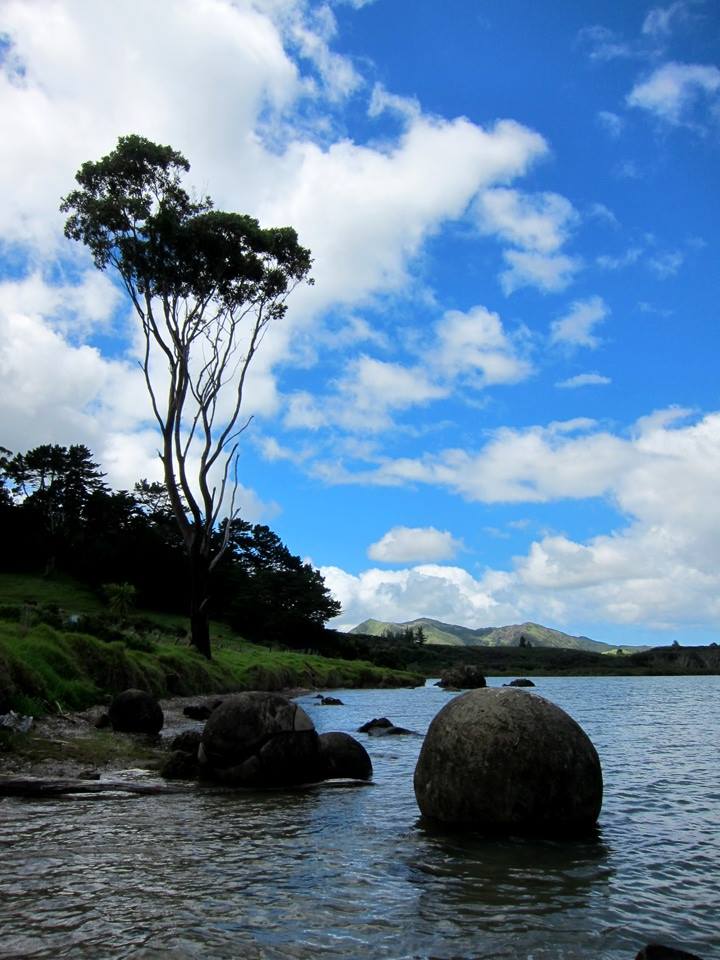
For an hour we had the beach, the peace and the sunshine to ourselves. The only noises we heard were our own; the water of the Hokianga harbour was so calm it barely formed ripples. It’s easy to forget we’re actually by the sea, save for the presence of a few jellyfish and the faraway sand dunes.
After the disappointing weather at Cape Reinga and the mad dash to get here in the morning, we were in no hurry to move on from our little slice of paradise. It was the unexpected highlight of our road trip around Northland.
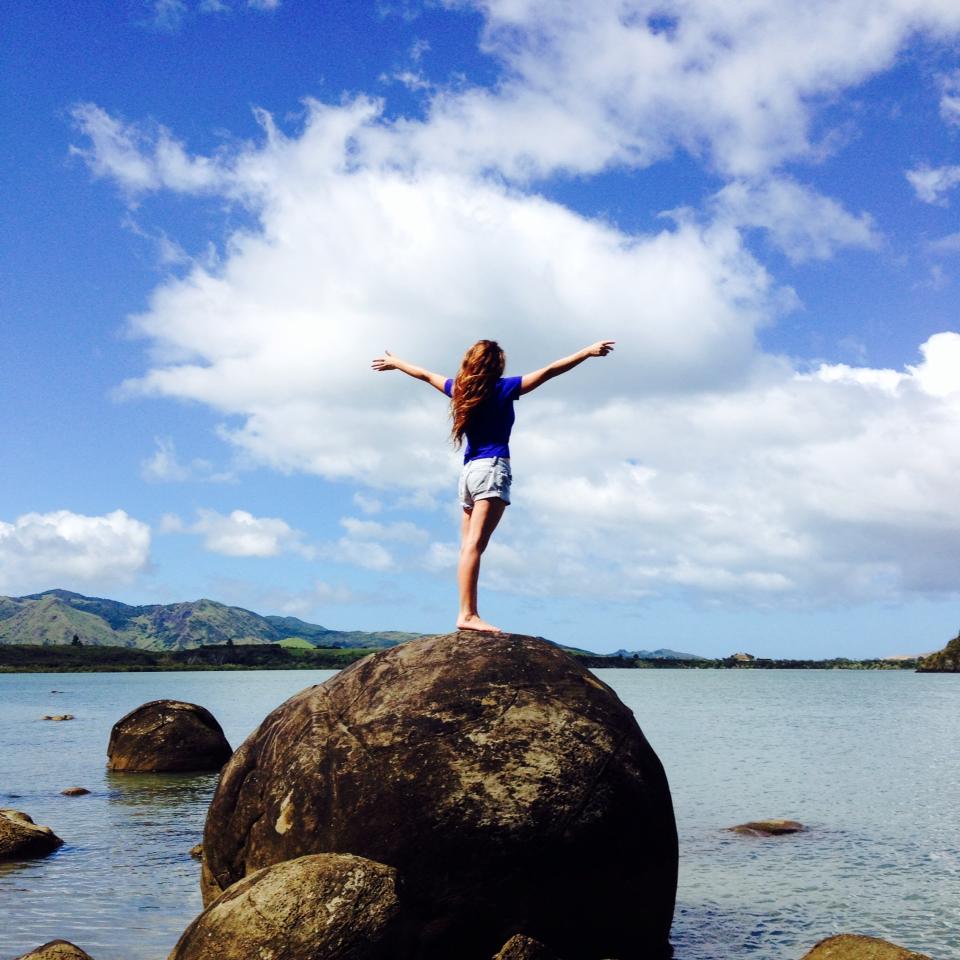
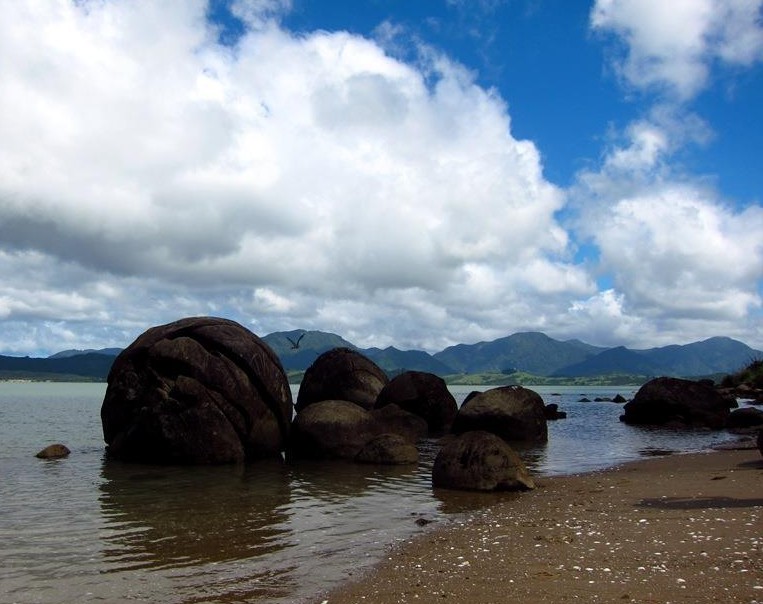
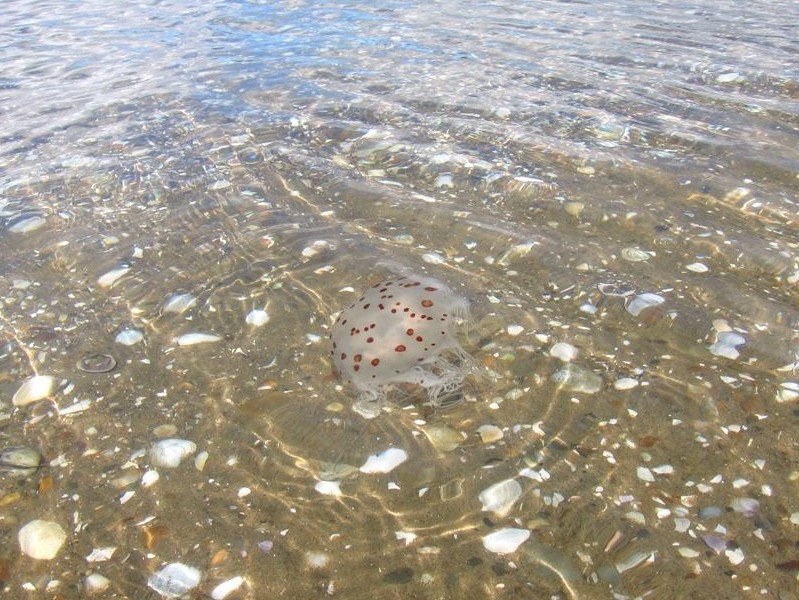
But alas, the rising tide forced us to leave before we were cut off from the car. We were now shin-deep in water in places where we trod on sand earlier on, but it was cool to have mangrove fish swimming among our feet. Luckily we were wearing shorts and slippers, unlike the two gentlemen heading to the boulders we encountered. What were they thinking anyway, wearing jeans and trekking shoes on a beach?
Find out the road trip route I took to get here at 10 Alternative New Zealand Road Trips
Getting to the Koutu boulders
From SH12, turn into Koutu Loop Road, and then follow Waione Road until you reach the gate in front of the mangroves with the Koutu boulders signpost. Park here, walk to the beach, turn right and keep going – the further you go the bigger they get! Alternatively, keep driving on Waione Road, turn right into Cabbage Tree Bay Road and park just after No. 76. Follow the path to the beach and turn left.
Moeraki Boulders
Fast forward 3 months, and I was on the motorway heading towards Dunedin. As before, I was desperate to leave disappointment behind in Oamaru. I picked up a hitchhiker who indicated that he wanted to visit Koekohe Beach to see the Moeraki boulders too. My experience in Koutu hadn’t killed my interest in checking the more renown South Island counterparts, so I agreed to take him there.
The similarities end there, however, and the site bore all the hallmarks of a well-developed attraction.
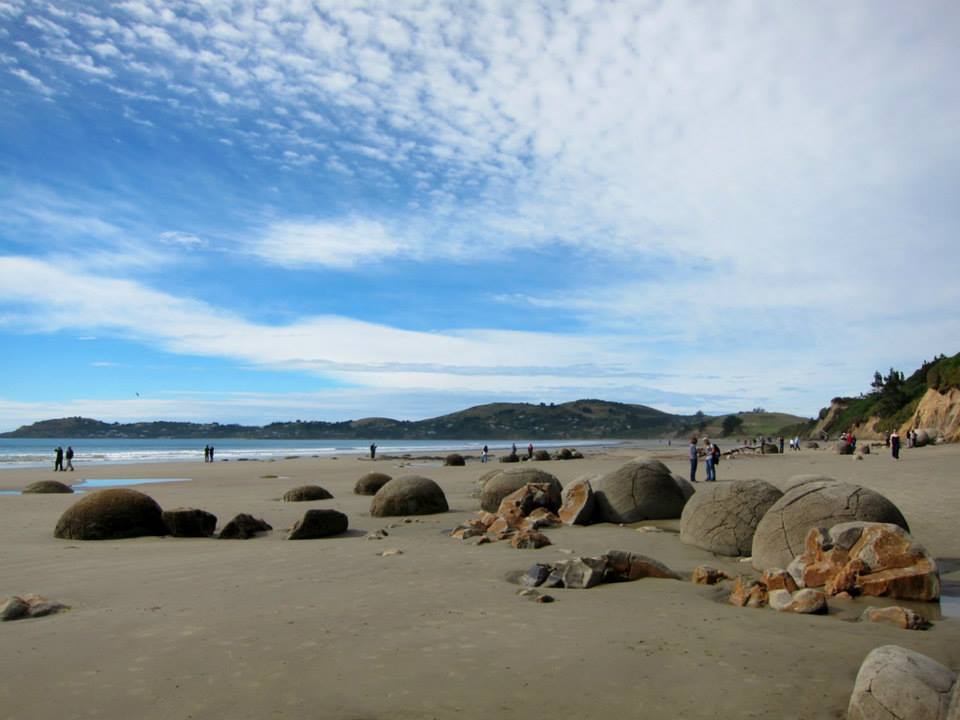
The motorway passes close to the beach where the boulders are and a short sealed road leads to the car park. I had timed the visit to coincide with the low tide; judging by the cars and tour buses there, it looked like everyone else did so too. We were able to get the car into the last available spot, but only just.
It’s a flat and sandy beach that should pose no problems to the able-bodied. Thanks to a ramp next to the cafe, it’s also wheelchair accessible. Brunch and coffee with a view of the Pacific Ocean is an option here and the gift shop reminds you that you can buy the perfect photos you could never take.
No wonder that there were 40-odd people with us. A good number of them were wearing pants and trekking shoes on the beach.
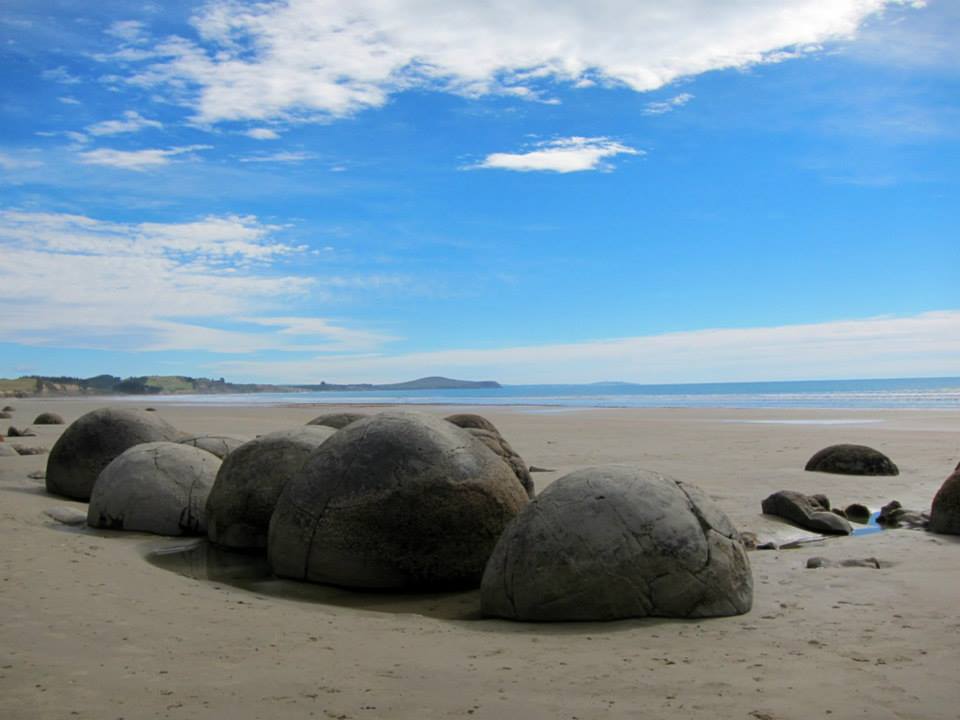
According to Maori legend, the formations here are the petrified flotsam of the canoe which brought their ancestors to the South Island. I’m not aware of similar explanations for the Koutu boulders, so I’m sticking with giant rabbits for those. There used to be more rocks on the beach but visitors hauled away some of them in the past. They are still plentiful at nearby Shag Point, where the Katiki boulders are found; these also contain visible dinosaur fossils.
The small cluster that’s left at Moeraki, set in the sand on an otherwise empty beach, seemed more like the result of a freak incident than a larger natural phenomenon. They were equally interesting to look at up close as they were against the vast ocean: Marbled cracks had formed on some of the concretions like the stitching on a football. A few of the larger specimens that have split open lend themselves to creative ideas.
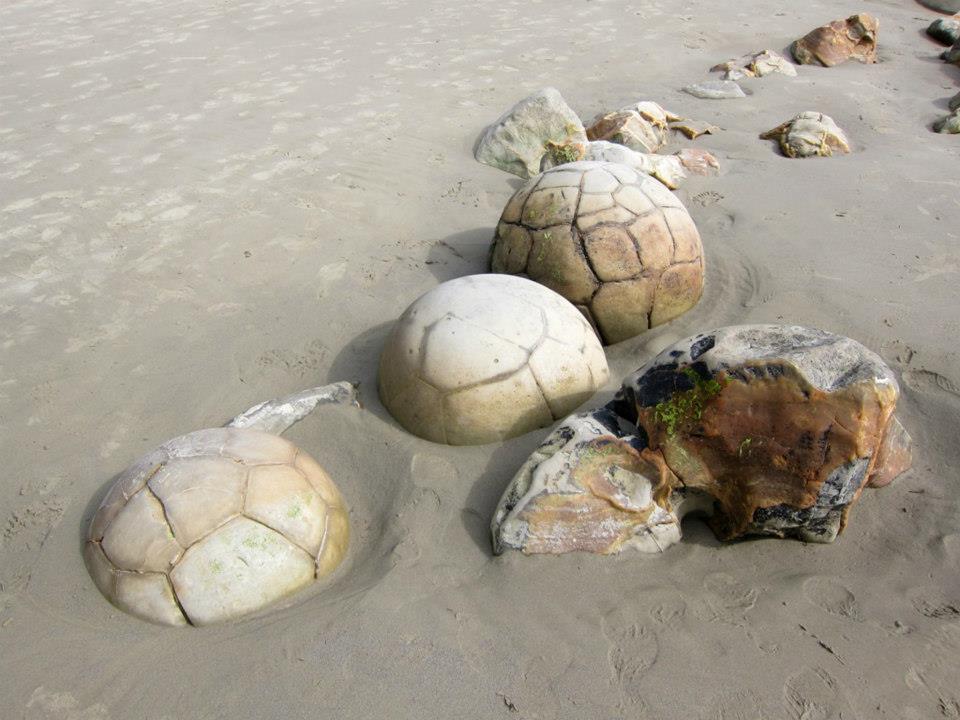
Unlike rugged Koutu, this was not the place for quiet contemplation – not when there were more lenses than boulders on the beach. Everywhere we looked, there were people straddling, leaping and posing. It’s impossible to sit still for a long time without becoming a blight on someone else’s photographs.
All told, we still had a lot of fun at the Moeraki boulders, and it’s perfect for a quick scenic pit stop on the long drive between Dunedin and Oamaru. I can still appreciate that not everyone can access the more isolated boulders at Koutu and Shag Point, but the work it takes to get there pays off for those who can.
Getting to the Moeraki and Katiki boulders
The turn-off point for Moeraki boulders is well signposted along SH1. Finding an empty lot in the car park will probably be your biggest concern. For the Katiki boulders, drive further south along the motorway to the road that leads to Shag Point. They are below the sea-facing houses and can be accessed via a path to the left of No. 183. Turn left to get to the boulders and watch out for the fur seals!
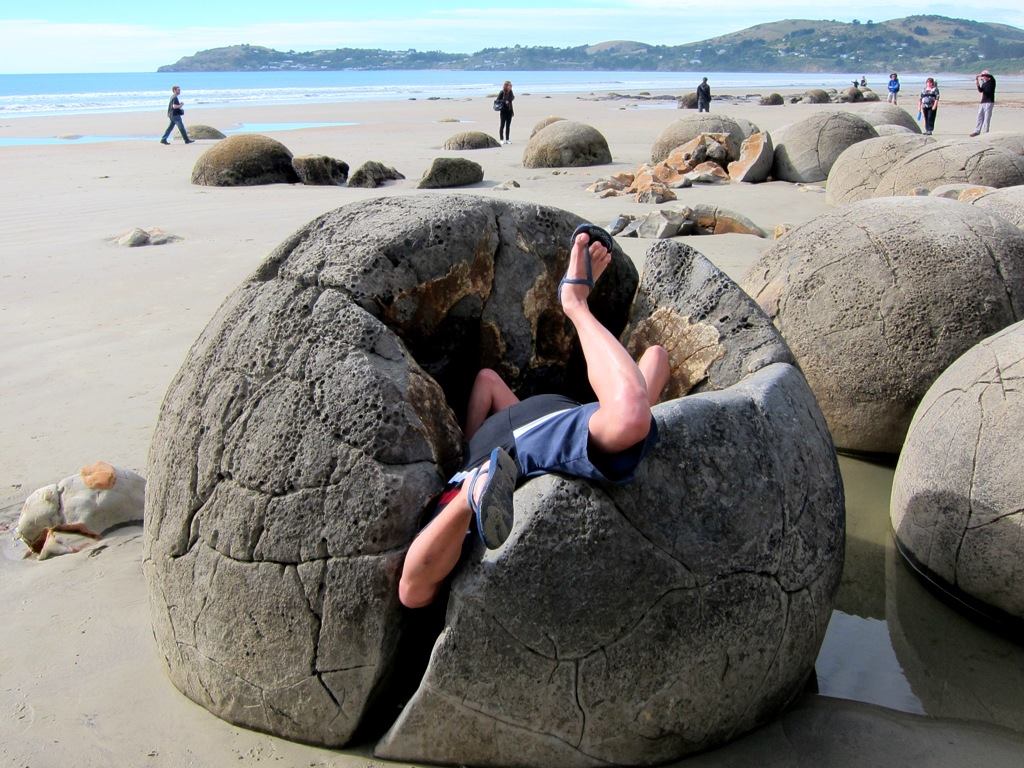
09/10/2014 @ 5:00 PM
Wow that looks amazing! I’ve never seen boulders of such a round shape!
16/10/2014 @ 7:14 PM
I couldn’t believe it either when I first read about them!
11/05/2018 @ 10:21 PM
There are also boulders like this on the coast south of Waimarama in Hawkes Bay… a bit of a walk but well worth the effort. I didn’t know about the ones at Hokianga though, so thanks for that!
26/05/2018 @ 9:08 AM
Thanks for the tip, Dave. I looked them up and the images of the boulders with Bare Island in the background look stunning.
26/05/2018 @ 3:26 PM
Yeah I walked down to Bare Island… was a hard slog. I nearly got caught by the tide coming back. It was winter 2002 & the lighting was bad & I only had film camera back in those days, so only took a couple of shots. Still haven’t managed to get back there for a better look…
Travelling New Zealand in a campervan: The best places to visit! - Befreewithlee
24/07/2020 @ 11:48 AM
[…] some spectacular landscapes.Sitting at the top of my list of things to see in the area are the Koutu Beach boulders. These giant round boulders (up to three metres wide) dot the coastline beneath the pines and […]
12/01/2021 @ 3:24 PM
Totally agree with you.
Our Koutu boulder hide away is a perfect place to visit.
Visit when the tide is out but perhaps not as pretty.
11/02/2021 @ 9:06 AM
Thanks for your comment, Glo. I hope it has remained relatively uncrowded.